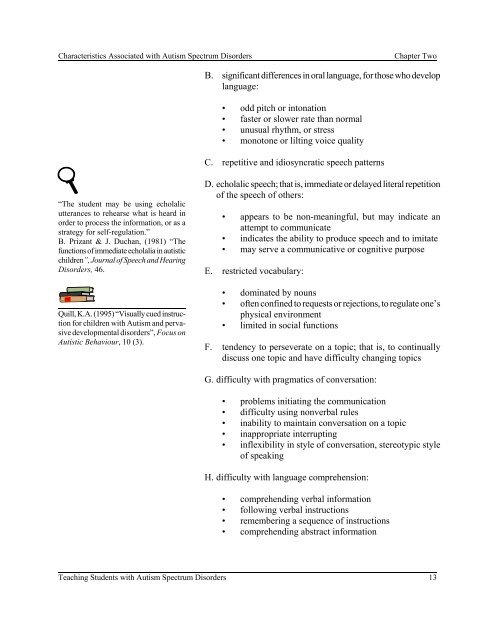Teaching Students with Autism Spectrum Disorders
Teaching Students with Autism Spectrum Disorders
Teaching Students with Autism Spectrum Disorders
You also want an ePaper? Increase the reach of your titles
YUMPU automatically turns print PDFs into web optimized ePapers that Google loves.
Characteristics Associated <strong>with</strong> <strong>Autism</strong> <strong>Spectrum</strong> <strong>Disorders</strong> Chapter Two<br />
“The student may be using echolalic<br />
utterances to rehearse what is heard in<br />
order to process the information, or as a<br />
strategy for self-regulation.”<br />
B. Prizant & J. Duchan, (1981) “The<br />
functions of immediate echolalia in autistic<br />
children”, Journal of Speech and Hearing<br />
<strong>Disorders</strong>, 46.<br />
Quill, K.A. (1995) “Visually cued instruction<br />
for children <strong>with</strong> <strong>Autism</strong> and pervasive<br />
developmental disorders”, Focus on<br />
Autistic Behaviour, 10 (3).<br />
B. significant differences in oral language, for those who develop<br />
language:<br />
• odd pitch or intonation<br />
• faster or slower rate than normal<br />
• unusual rhythm, or stress<br />
• monotone or lilting voice quality<br />
C. repetitive and idiosyncratic speech patterns<br />
D. echolalic speech; that is, immediate or delayed literal repetition<br />
of the speech of others:<br />
• appears to be non-meaningful, but may indicate an<br />
attempt to communicate<br />
• indicates the ability to produce speech and to imitate<br />
• may serve a communicative or cognitive purpose<br />
E. restricted vocabulary:<br />
• dominated by nouns<br />
• often confined to requests or rejections, to regulate one’s<br />
physical environment<br />
• limited in social functions<br />
F. tendency to perseverate on a topic; that is, to continually<br />
discuss one topic and have difficulty changing topics<br />
G. difficulty <strong>with</strong> pragmatics of conversation:<br />
• problems initiating the communication<br />
• difficulty using nonverbal rules<br />
• inability to maintain conversation on a topic<br />
• inappropriate interrupting<br />
• inflexibility in style of conversation, stereotypic style<br />
of speaking<br />
H. difficulty <strong>with</strong> language comprehension:<br />
• comprehending verbal information<br />
• following verbal instructions<br />
• remembering a sequence of instructions<br />
• comprehending abstract information<br />
<strong>Teaching</strong> <strong>Students</strong> <strong>with</strong> <strong>Autism</strong> <strong>Spectrum</strong> <strong>Disorders</strong> 13

















